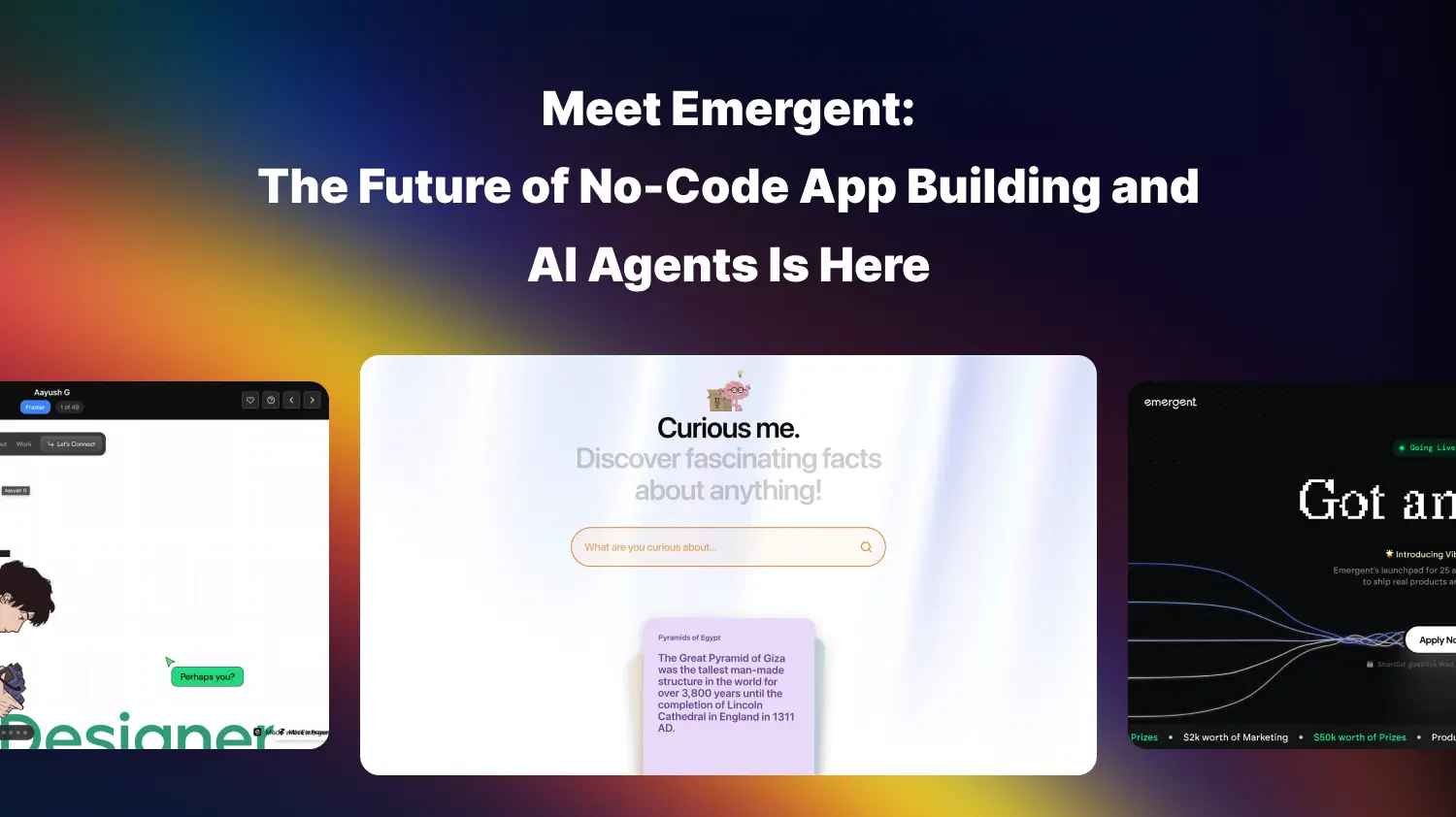Meet Emergent: The Future of No-Code App Building and AI Agents Is Here
- AI News
- 6 min read
- August 26, 2025
- Harish Prajapat
What is Emergent?
Emergent is a powerful new AI platform revolutionizing how software is created. It allows users to build full-stack applications using plain language prompts—no coding required. With a focus on speed and flexibility, Emergent eliminates the need for traditional development pipelines, replacing them with an agent-based system capable of ideation, planning, coding, testing, and deployment.
The real magic? You simply describe what you want, and Emergent’s autonomous agents take over. From frontend layouts to backend logic, it brings your ideas to life with production-ready results in minutes.
Key Features of Emergent
-
No-Code, Prompt-Based Development
Build complex applications using natural language, with no technical expertise needed. -
Multi-Agent Collaboration
A team of AI agents coordinate on task breakdown, coding, debugging, and optimization. -
Full-Stack Automation
Emergent handles frontend, backend, database, and deployment—end-to-end automation. -
Rapid Prototyping to Deployment
Launch a working version of your app within minutes, not weeks. -
Developer-Inspired
Built by engineers with a deep understanding of how developers work, Emergent optimizes for developer-like quality with AI speed.
Emergent and the Rise of Agentic AI
Emergent is more than just a tool—it’s part of a larger shift in artificial intelligence toward agent-based systems, where multiple AI agents collaborate autonomously on complex, multi-step tasks.
This approach is gaining momentum across the tech industry. Giants like Amazon and OpenAI are exploring similar paradigms, recognizing the power of agents that can reason, act, and improve over time.
Agentic AI is seen as the next leap in artificial general intelligence, enabling AI to not just generate content, but also execute plans, monitor results, and adapt dynamically—just like a human team would.
“We are moving from tools to teammates,” says AI researchers about this next wave of intelligent agents.
Spark vs. Lovable AI vs. Emergent
| Feature / Tool | GitHub Spark | Lovable AI | Emergent |
|---|---|---|---|
| Core Focus | Micro-app generation inside GitHub | Prompt-based UI builder | Full-stack autonomous app development |
| Use Case | Internal tools, simple micro-apps | Early-stage product UI design | Complete app creation from prompt to deployment |
| Backend Integration | Basic data store, auth, GitHub infra | No backend generation | Yes – full backend with DB, auth, API, hosting |
| Frontend Control | Basic UI via prompt | Clean UI layouts, exportable code | Full-stack frontend generation with flexibility |
| Deployment | Seamless GitHub deployment | Manual export & deploy | Automatic deployment with built-in hosting |
| Code Export | Limited (GitHub hosted only) | Clean HTML/CSS/JS or React | Full source code export in various stacks |
| Ease of Use | Extremely easy for devs | No-code, great for non-devs | Natural language-based, designed for all skill levels |
| Agent Support | Not supported | Not supported | Multi-agent orchestration engine |
| Best For | Devs building quick tools in GitHub | Non-devs/startups designing UIs | Founders, builders creating full-scale AI-first apps |
| AI Interaction | Prompt-to-app | Prompt-to-UI | Multi-turn prompt orchestration with agents |
Real-World Use Cases of Emergent
Emergent is not just a theoretical AI model – it’s already driving innovation across multiple industries. Here are some detailed, real-world scenarios where companies and developers are using Emergent to save time, reduce costs, and unlock creative potential:
1. Internal Business Tools at Scale
Companies are leveraging Emergent to build tailored internal tools such as CRM dashboards, inventory trackers, HR portals, and operations panels—all within minutes. Instead of relying on lengthy dev cycles, businesses can now describe what they need and let Emergent generate fully functional UIs with integrated logic.
2. Launching MVPs for Startups
Startups are using Emergent to go from idea to launch rapidly. Whether it’s a fintech platform, a SaaS analytics tool, or an AI-powered marketplace, founders simply describe the concept and Emergent builds both frontend and backend scaffolding. This significantly reduces time to validate ideas and present working prototypes to investors or early users.
3. Automating Customer Service Applications
Emergent is helping businesses automate customer support by generating dynamic help centers, chatbot interfaces, and issue resolution pipelines. With its multi-agent architecture, it can orchestrate flows between user input, knowledge base access, ticket creation, and more—all without coding from scratch.
4. AI-Generated SaaS Dashboards & Data Pipelines
Product teams are deploying Emergent to create complex SaaS dashboards that visualize user activity, performance metrics, or transactional data. Its ability to generate full-stack components also allows for the automatic integration of databases and real-time analytics pipelines, saving weeks of backend engineering work.
5. UI/UX Testing with AI-Generated Variants
Designers and growth teams are using Emergent to generate multiple versions of landing pages, signup flows, or dashboards—each with different design treatments, layouts, or CTA placements. These can then be A/B tested at scale, allowing for faster optimization cycles using AI-assisted creativity.
How to Try Emergent
Emergent is currently open for early access. You can request access and start building apps right away through their official site:
Frequently Asked Questions
Emergent is used to build web apps using AI, replacing traditional software development with prompt-driven automation.
No. Emergent is designed for both technical and non-technical users to build apps using plain language.
It currently offers early access through an invite model. Pricing may vary once it launches fully.
Emergent uses multi-agent intelligence—several AI models working together to simulate a full development team



